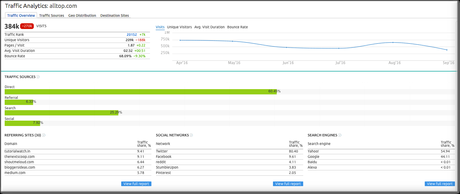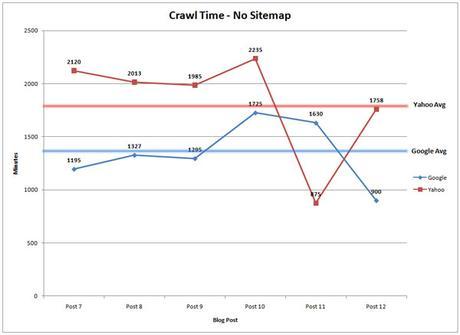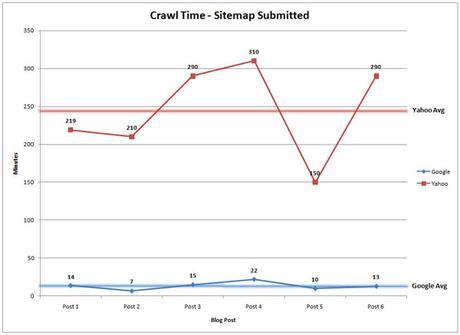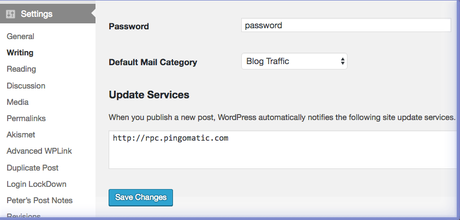I bet you’ve landed on this page searching for answers about WordPress pings, possibly (secretly?) hoping it just might be the golden ticket to your blog being discovered and loved by the world…
Well, maybe not quite so dramatic, but nonetheless…
Let me ask you this: have you noticed yet how hard it is to find any current information about WordPress pings?
And the information that IS out there… might actually put all kinds of wrong ideas into that pretty head of yours!
It might even tell you that if you use a lengthy list of ping services, your blog will get TRAFFIC. Tons of it, no doubt.
<a moment of silence>
Really? Traffic falling from Heavens like manna?…
<I bet you already know where I am going with this>
If getting website traffic was as easy as a ping, Traffic Generation Café wouldn’t be here. Yet here I am, still blogging about traffic since 2011…
So let’s cut through the hogwash and find out:
- what is a ping?
- what does it do?
- how many services do you really need to ping?
- how does it affect your SEO (if at all)?
NOTE (and a disclosure of sorts)
I really believe that pinging is NOT something you should concern yourself with. It’s just non-essential to your online presence.
There are better, more productive, AND traffic-driving ways to let the search engines know you’ve got fresh content.
So forgive me for treating the subject with a bit of impatience.
However, since you, my dear Reader, are searching for answers, I’ll do my best to give them to you. Yes, I am pretty sweet that way… ?
What is a ping?
A “ping” is actually a term that relates to a test to find out how fast a data signal can travel from one place to another.
A ping sends a “packet” of electronic data to a specific IP address and “waits” for an electronic signal/tone that’s known as a “pong.” (source)
And no, no relationship to ping pong…
By the way, the word ‘ping’ came from the sound that a submarine’s sonar makes when it bounces off physical objects underwater.

What Is a WordPress Ping?
In WordPress terms:
A ping is a “this site has new content” notification that invites search engine bots to visit your blog.
Within the WordPress interface, “ping” could also be used to refer to Pingbacks and Trackbacks.
When you ‘ping’ a blog post, what you are really hoping for is:
- to notify sites that display blogrolls that you’ve got new content to be displayed in those blogrolls for the world to see and bring you traffic. (A-HA!… that’s where the whole ‘traffic’ part comes from!)
- to notify blog indexing sites (like Technorati) that you’ve got new content so that they could list it… somewhere… on their site and bring you traffic. (more traffic!)
- to notify search engines (let’s face it, you mean ‘Google’) that you have new content to crawl, index, and list in their search engine page results (SERPs).
Let’s take that apart for a moment…
Blogrolls drive traffic?
Here’s an excerpt from the WordPress Codex page about pings:
Blogrolling scripts like blogrolling.com and WordPress check update services to see if you’ve updated and then shows it on everyone’s site — usually by moving you to the top of people’s blogrolling list or putting a recently updated indicator by your link.
Problem is… blogrolling.com no longer exists and… when was the last time you saw a blogroll displayed on anyone’s site?
(By the way, if you HAVE recently seen one of those, send them the link to this post and tell them to get rid of the dang thing!)
So blogrolls as a reason to ping your blog is out and, sadly, website traffic from blogrolls is out too.
Blog indexing sites drive traffic?
The biggest and most famous one of those would be Technorati.
Everyone knows Technorati, right? Even that official WordPress Codex page mentions Technorati as one of the services they ping… (just goes to show how outdated that page is!)
Trouble is… Technorati is not longer the Technorati it used to be. It’s now Technorati the advertising platform.
After a half-decade of helping blogs and self-published websites gain exposure, Technorati took the natural step of helping those same types of websites earn revenue through an advertising platform launched in 2008.
Are there any other blog indexing sites that still exist?
Yes. Alltop comes to mind.
Alltop is a good example of a blog indexing site: a bunch of links from various blogs on various topics.
Out of curiosity (and nerdiness, of course!), let’s take a look at Alltop traffic sources using SEMrush.com, my hands-down favorite SEO and marketing intelligence tool.

You can see the page for yourself here.
Wow, look at how sharply Alltop traffic has dropped since last month; they’ve managed to lose nearly half of it! Hit by Google Penguin? It’s a possibility…
On the other hand, always seems like Alltop promotion lays squarely on the shoulders of ONE person – Guy Kawasaki, Alltop co-founder, as well as the creator of Canva.
Looks like Guy is running out of steam…
Anyhoo… I digress.
Just trust me on this one – you won’t be getting any traffic from blog indexing websites.
That boat has sailed like a decade ago.
What to do to ACTUALLY drive traffic to your site?
…besides reading Traffic Generation Café?
Reading and DOING what you read about at Traffic Generation Café.
Like Kurt Frankenberg did and, as a result, increased his traffic 89% in 28 days.
Here are some good reads to start (or continue) mastering your traffic generation:
How to Increase Website Traffic One Perfect Bite at a Time
Social Media Traffic 101: How to REALLY Get Traffic from Social Media
Increase Website Traffic: The Ultimate Blueprint to More Profitable Web Traffic
Promote Your Blog: 10 Steps to Ultimate Blog Promotion [My Personal Cheat Sheet]
And some shorter, more bite-sized Traffic Hacks:
How to Turn a Blog Post into a Video in 5 Minutes [Traffic Hack]
Be Everywhere: How to Convert a Blog Post into PDF in Under 60 Seconds
How to Get Links and Traffic from Flickr [#TrafficHack]
Good stuff? ?
Could pinging possibly help with search engine rankings?
Um… NO.
Could pinging help the search engine bots discover your content? A-ha… now we are on the right track.
What we are really talking about here is crawling and indexing.
You can learn more about how Google works here, but let me briefly tell you what Googlebot is and the difference between indexing and crawling.
Googlebot is Google’s web crawling bot (sometimes called a “spider”).
Crawling is the process by which Googlebot discovers new and updated pages to be added to the Google index.
Indexing is the processing of the information gathered by Googlebot during crawling. The pages are then added to Google’s searchable index.
Thus pinging you new or freshly updated content could, in fact, invite Googlebot to crawl it.
However, pinging is far not the most effective way to get Google to crawl and index your site.
Here’s what I’d rather see you do.
1. Add a sitemap
A sitemap is a file where you can list the web pages of your site to tell Google and other search engines about the organization of your site content.
Search engine web crawlers like Googlebot read this file to more intelligently crawl your site.
Do you have to have a sitemap?
According to Google, not really.
However:
If your site’s pages are properly linked, our web crawlers can usually discover most of your site. Even so, a sitemap can improve the crawling of your site.
Can’t help but mention Casey Henry’s experiment in which he set to find out whether a sitemap can boost search rankings.
The results blew him away.
When he installed the Google XML sitemaps generator (a free WP plugin) on a client’s website, it took an average of 14 minutes for Google to index new pages.

That was way, way, waaaaaay down from 1,375 minutes it took before he installed the sitemaps generator!

Creating a sitemap is easy. You just let a plugin do all the creating.
Use either Google XML sitemaps generator or, if you have Yoast SEO already installed on your site (or thinking of installing it), use its built in sitemap functionality.
2. Share your post on social media
It’s simple: Googlebot discovers sites by following links from page to page.
When you share your content on bot-infested social media, the bots will follow your link from that page (your social media share) to your blog post page.
Needless to say, unlike traffic from blogrolls or blog index sites, social media traffic does exist!
3. May or may not help, but good to do anyway
Make sure you install Google Analytics tracking code on your site, as well as claim it in Google Search Console.
Also, contrary to many blog posts I’ve read, I don’t believe that using Fetch as Google function in Google Search Console will get Googlebot to crawl/index your site faster.
It’s meant to test if Google can crawl your web page, how it renders the page, and whether any page resources (such as images or scripts) are blocked to Googlebot, and is useful for debugging crawl issues on your site.
My WordPress Ping Services List
Back to the world of ‘to ping or not to ping.’
By default, WordPress pings one service called Ping-o-matic; that service will in turn ping others.
Why Ping-o-matic?
Because it’s owned and run by the WordPress Foundation, a charitable organization founded by Matt Mullenweg, founder of WordPress and current CEO of Automattic.
I’d say Matt knows what he’s doing when it comes down to WordPress… wouldn’t you?
Boom! There you go. Done.
I officially declare that Ping-O-Matic is the only update service your blog needs.
All you need to do is to go to Settings > Writing > Update Services to make sure http://rpc.pingomatic.com is the only update service listed there.

And just in case you still insist on holding onto that huge list of update services of yours (or more like another blogger’s list you’ve copied, trusting them to know what they are doing… really?), read on.
Too Much Pinging Could Cost Google Rankings?
Back in the day when a crappy backlink seem to be better than no backlink at all, we had mile-long lists of update services we just had to ping.
These days, that (let’s face it) shady tactic could be outright damaging to your site.
Take a look at what Glen Allsopp wrote in one of his ViperChill.com posts, after he had sent out a tweet concerning his lower than expected search engine rankings:
“I received a personal reply from Google’s head of web-spam, Matt (Cutts), who asked me if, when a blog post goes live, I ping certain services…
Though I wasn’t pinging the services Matt asked me about, I was pinging a few with a foreign domain extension that he had mentioned and a lot of others, so I decided to remove all but a couple of them from my list.
A few days later and my rankings were back where they should be.
How crazy is it that some behind the scenes WordPress setting was costing me search rankings for my own brand name?”
So… while I wouldn’t worry too much about pinging too little, pinging too much could potentially be a problem.
Could You Be Pinged as a Spammer?
There’s one more thing about pinging too much.
By default, WordPress.org pings update services like Ping-O-Matic EVERY time a post is edited.
Do you like to edit your posts ruthlessly like I do – even way after they’ve been published?
Our relentless editing could result in excessive pinging. Could we be ‘pinged’ as spammers as a result?
There are plenty of disagreements on the issue.
However, let’s be reasonable here.
Have you ever heard of any site penalized by Google or any other search engine for excessive pinging? Neither have I.
But if you are a “better safe than sorry” kind of person, installing a ping-controlling plugin like WordPress Ping Optimizer will give you peace of mind.
(DISCLOSURE: I don’t personally use any pinging plugins, so can’t vouch for any of them. I prefer to use as few plugins as possible – I think there’s more danger in a hacker finding a door to your site through a plugin than an imaginary penalty from excessive pinging.)
Marketing Takeaway
You’ve got 30 seconds to update your ping list.
Go to Settings > Writing > Update Services.
Time starts now…
From Ana with ❤️,


